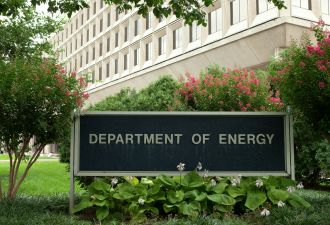After years of bargaining, Pacific Gas & Electric officially launched its EV Charge Network pilot program on Wednesday.
It’s the largest utility-sponsored EV charging program in the country. The results could offer lessons on the best path forward for other states that hope to implement EV adoption at the scale of the country’s largest market. California has 6.65 electric cars per 1,000 people, but infrastructure remains a persistent barrier to large-scale EV uptake in the state and around the U.S. Many argue that utilities hold the key.
PG&E’s program includes 7,500 Level 2 chargers and a budget of $130 million. The utility will pay for all of the infrastructure costs, “from the transformer to the parking space,” according to spokesperson Ari Vanrenen.
The first customer, Merced College, will begin installations in Q1 of 2018. By the end of 2020, the six chargers installed there will multiply to spots at condominiums, apartments and offices across PG&E’s 70,000-square-mile service area in Northern and Central California. So far, PG&E has fielded interest from over 500 customers who would like to install chargers.
Vanrenen said PG&E will choose sites based “specifically...[on whether] they are where EV charging access has been limited and where cars are more likely to sit for longer periods of time.” Between 15 and 20 percent of the chargers will be installed in underserved neighborhoods.
Getting the program up and running hasn’t been easy for California’s largest utility. PG&E initially proposed a $654 million charging program to the California Public Utilities Commission in February 2015. The CPUC rejected the plan and asked the utility to try again.
After the utility’s second attempt, industry players including the Electric Vehicle Charging Association and ChargePoint drafted a counterproposal that they said would foster more innovation and competition by allowing site hosts to determine rates and manage chargers. It was also cheaper and included fewer chargers.
The CPUC decided on a compromise that won plaudits from environmental groups and many in the EV industry. Vanrenen said a PG&E program advisory council, which began meeting last May, formalized the collaboration and outreach the utility had fostered over the years. The council of 35 external parties includes a variety of stakeholders such as the Sierra Club, the Natural Resources Defense Council, General Motors, Honda, ChargePoint and Greenlots.
“This...program we’re announcing is the result of all that hard work,” said Vanrenen.
The 7,500-charger initiative joins existing programs in California from Southern California Edison (SCE) and San Diego Gas & Electric (SDG&E), which both launched EV infrastructure pilots in 2016. The CPUC approved a $22 million SCE program for 1,500 chargers and a $45 million SDG&E project for 3,500 chargers.
PG&E’s initial proposal was much bigger than other utility plans, although PG&E’s service area is larger.
SCE’s program allows the utility to own all of the infrastructure, except for the actual chargers. SDG&E owns all of the infrastructure and the chargers, while allowing for customer choice in vendors and third-party partnership.
Ownership was another central source of conflict in developing PG&E’s plans. PG&E's initial proposal allowed the utility to control both hardware and software for all of its chargers. The utility and CPUC finally settled on a split ownership model that caps PG&E’s potential ownership at 35 percent of the program’s chargers. Site hosts can choose to own and manage their chargers.
For each installation in PG&E’s service area, site managers will choose from a list of 15 approved EV charge network vendors, including companies such as ChargePoint, Shell New Energies and Greenlots. PG&E will open a quarterly application to allow more vendors to qualify for inclusion on that list.
Loosening PG&E’s grip on infrastructure was integral to gaining support from many industry players. But according to Greenlots CEO Brett Hauser, allowing utilities at least some control over charging hardware and software will be integral to successfully expanding EV infrastructure.
“If we want to move electrified transportation to a broad base, we need to make sure that there’s equitable access to the infrastructure,” he said. “If it’s left to competition alone, you’re going to see clustering of charging stations in certain places. We think utilities have to play a role.”
As EV ownership expands, Hauser said that making sure utilities understand how customers use chargers will be essential to ensuring that infrastructure is located where it’s needed.
“Site hosts should have the ability to pick and choose a charging station based on their specific use-case needs for their site -- every charge station has different features and functionality,” he said.
He added: “If utilities don’t have visibility into these assets and how they’re being utilized, they can’t properly plan for their investments. The more visibility and control they have from a system-networking perspective, the better off their customers and ratepayers will be."
Next, PG&E will focus on the rest of the transportation sector. According to Vanrenen, the utility has filed a proposal with the CPUC to install charging infrastructure to support medium- and heavy-duty vehicles. PG&E expects a decision on those regulatory processes in the spring.
Hauser, too, sees the medium- and heavy-duty sector as the industry’s next step. California, ever the "first mover," as Hauser put it, is working on the challenge.
Earlier this month, the CPUC approved 15 transportation electrification proposals worth $43 million. Some of that money will go to electrification and electric infrastructure for medium- and heavy-duty vehicles like school buses, long-haul trucks and yard tractors.
SCE had four transportation projects approved by CPUC, including a transit bus electrification program. Laura Renger, principal manager of air and climate at SCE, said it's important for utilities to be active in the EV space for several reasons.
"We know we cannot meet the state's 2030 greenhouse gas goals without a significant investment in EVs," she said on a call last week with reporters.
"We have relationships with all of our customers," Renger said. "We also have the size and the scale and the ability to really bring about market transformation needed to transform our transportation sector. We have played a role in market transportation in energy efficiency and renewable energy, and we’re really excited to do the same thing here with electric vehicles.”




